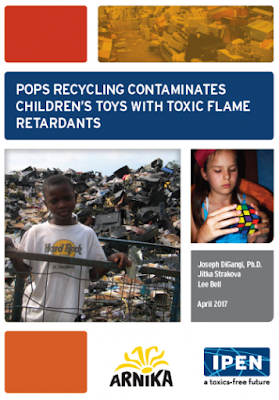POPs Recycling Taints Plastic Children’s Toys with Toxic Chemicals from E-Waste
A new global survey finds that recycling plastics
containing toxic flame retardant chemicals found in electronic waste results in
contamination of the world’s best-selling toy along with other children’s
products.
Ironically, the chemical contaminants can damage the nervous system and reduce
intellectual capacity but are found in mostly imitation Rubik’s Cubes – a
puzzle toy designed to exercise the mind.
The study was performed by IPEN (a global civil society network) and Arnika (an
environmental organization in the Czech Republic )
in cooperation with partner groups from 26 countries, including the EcoWaste
Coalition from the Philippines
The toxic chemicals Octabromodiphenyl ether (OctaBDE), Decabromodiphenyl ether
(DecaBDE), and Hexabromocyclododecane (HBCD) are used in the plastic casings of
electronic products and if they are not removed, they are carried into new
products when the plastic is recycled.
The study was released just a few days before the eight Conference of the
Parties (COP8) to the Stockholm Convention on Persistent Organic Pollutants (POPs) will decide whether to continue
allowing the recycling of materials containing OctaBDE and possibly make a new
recycling exemption for DecaBDE. The treaty’s expert committee has warned
against the practice.
According to the study, 90% of the samples contained OctaBDE or DecaBDE,
and 43% contained HBCD. These chemicals are persistent and known to harm the
reproductive system and disrupt hormone systems, adversely impacting
intelligence, attention, learning and memory.
“Materials containing toxic flame retardant chemicals such as OctaBDE and
DecaBDE should not be ‘recycled’ into children’s toys,” said Thony Dizon,
Coordinator of the EcoWaste Coalition’s Project Protect.
At a meeting with the Environmental Management Bureau and other stakeholders
last Tuesday, April 18, the EcoWaste Coalition requested the Philippine
delegation to push for the end of toxic recycling exemption for brominated
diphenyl ethers in the Stockholm Convention.
“Recycling materials that contain toxic chemicals contaminates new products,
continues exposure, and undermines the credibility of recycling," said Pam
Miller, IPEN Co-chair. “Governments should end this harmful loophole.”
Another critical decision of the Stockholm Convention Conference will be to
establish hazardous waste limits. Protective hazardous waste limits would make
wastes subject to the treaty’s obligations for destruction – and not permit
their recycling. Surprisingly, some of the toxic chemical levels in children’s
products in this study exceeded proposed hazardous waste limits.
“We need protective hazardous waste limits,” said Jitka Strakova, Arnika. “Weak
standards mean toxic products and dirty recycling, which often takes place in
low and middle-income countries and spreads poisons from recycling sites into
our homes and bodies. “
The application of strict hazardous limits is also critical for brominated
flame retardants due to their presence in e-waste.
In many countries, the Stockholm Convention standards will be the only global
regulatory tool that can be used to prevent import and export of these
contaminated wastes, in many cases from countries with stricter legislation to
countries with weaker legislation or control.
The report can be accessed here:
http://ipen.org/documents/pops






Comments